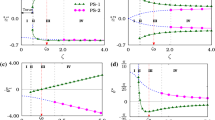Abstract
Three induces are discussed to study the new dynamics properties both analytically and numerically for noise-induced Fitzhugh-Nagumo system; the three induces are as follows: Lyapunov exponent, the density distribution of trajectories and power spectrum; the numerical experiment indicated that the noise can induce the system to quite regular dynamics, including coherence resonance (in the case of uncoupling) and stochastic synchronization (in the case of coupling), noise can control the dynamics properties and some other new phenomena that the synchronization takes place only for some moderate noise intensity is also found for the first time.







Similar content being viewed by others
References
Benzi R, Sutera A, Vulpiani A (1981) The mechanism of stochastic resonance. J Phys A 14:L453–L457
Benzi R, Parisi G, Sutera A et al (1982) Stochastic resonance in climatic change. Tellus 34:10–16
Benzi R, Parisi G, Sutera A et al (1983) A theory of stochastic resonance in climatic change. SIAM J Appl Math 43:565–578
Bulsara AR, Gammaitoni L (1996) Tuning into noise. Phys Today 49(3):39–45
Gammaitoni L, Hänggi P, Jung P, Marchesoni F (1998) Stochastic resonance. Rev Mod Phys 70(1):223–287
Gammaitoni L (2007) Noise limited computational speed. Appl Phys Lett 91(22):224104
Fauve S, Heslot F (1983) Stochastic resonance in a bistable system. Phys Lett A 97:5–7
Palonpon A, Amistoso J, Holdsworth J, Garcia W, Saloma C (1998) Measurement of weak transmittances by stochastic resonance. Opt Lett 23(18):1480–1481
Gammaitoni L (1995) Stochastic resonance and the dithering effect in threshold physical systems. Phys Rev E 52(5):4691–4699
Kang YM (2011) Coherence resonance in subdiffusive fractional Klein-Kramers periodic potential systems without a bifurcation precursor. Europhys Lett 94(6):60005
McDonnell MD, Abbott D (2009) What is stochastic resonance? Definitions, misconceptions, debates, and its relevance to biology. PLoS Comput Biol 5(5):e1000348
Hänggi P (2002) Stochastic resonance in biology. How noise can enhance detection of weak signals and help improve biological information processing. ChemPhysChem 3(3):285–290
McDonnell MD, Abbott D, Pearce CEM (2002) An analysis of noise enhanced information transmission in an array of comparators. Microelectron J 33:1079–1089
McDonnell MD, Stocks NG (2009) Suprathreshold stochastic resonance. Scholarpedia 4(6):6508
Bennett M, Wiesenfeld K, Jaramillo F (2004) Stochastic resonance in hair cell mechanoelectrical transduction. Fluctuations Noise Lett 4(1):1–10
Bulsara A, Hänggi P, Marchesoni F, Moss F, Shlesinger M (eds) (1993) Stochastic resonance in physics and biology. J Stat Phys 70:1–512
Longtin A, Chialvo DR (1998) Stochastic and deterministic resonances for excitable systems. Phys Rev Lett 81:4012
Rappel W, Strogatz S (1994) Stochastic resonance without an external periodic force. Phys Rev E 50:3249
Pikovsky AS, Kurths J (1997) Coherence resonance in a noise-driven excitable system. Phys Rev Lett 78(5):775–778
Lindner B, Schimansky GL (2000) Coherence and stochastic resonance in a two -state system. Phys Rev E 61:6103–6110
Neiman A et al (1999) Synchronization of the electrosensitive noisy cells in the paddlefish. Phys Rev Lett 82:660–663
Mosekilde E, Sosnovtseva OV, Holstein-Rathlou NH (2003) Nonlinear phenomena in nephron–nephron interaction. In: Pikovsky A, Maistrenko Y (eds) Synchronization: theory and application. Kluwer, The Netherlands, pp 139–174
Gang H, Ditzinger T, Ning CZ, Haken H (1993) Stochastic resonance without references external periodic force. Phys Rev Lett 71:807–810
Scott AC (1975) The electrophysics of a nerve fiber. Rev Mod Phys 47:487–533
Argentina M, Coullet P, Krinsky V (2000) Head-on collisions of wave in an excitable Fitzhugh-Nagumo system: a transition from wave annihilation to classical wave behavior. J Theor Biol 205:47–52
Pei X, Bachmann K, Moss F (1995) The detection threshold, noise and stochastic resonance in the Fitzhugh-Nagumo neuron model. Phys Lett A 206:61–65
Collins JJ, Chow CC, Imhoff TT (1995) Information measures quantifying aperiodic stochastic resonance. Phys Rev E52:R3321–R3324
Paydarfar D, Burkel DM (1995) Dysrhythmias of the respiratory oscillator. Chaos 5:18
Jung P (1994) Threshold devices: fractal noise and neural talk. Phys Rev E50:2513–2522
Jung P (1995) Stochastic resonance and optimal design of threshold detectors. Phys Lett A 207:93–104
Guckenheimer J, Kuehn C (2010) Homoclinic orbits of the Fitzhugh-Nagumo equation: bifurcations in the full system. SIAM J Appl Dyn Syst 9(1):138–153
Rankovi D (2011) Bifurcations of Fitzhugh-Nagumo excitable systems with chemical delayed coupling. Matematiqki vesnik 63(2):103–114
Bashkirtseva I, Ryashko L (2011) Analysis of excitability for the Fitzhugh-Nagumo model via a stochastic sensitivity function technique. Phys Rev E83:061109
Wolfe A, Swift JB, Swinney HL, Vastano JA (1985) Determining Lyapunov exponent from a time series. Phys D 16:285–317
Miguel SM, Toral R (2000) Stochastic effects in physical systems. In: Tirapegui E, Martinez J, Tiemann R (eds) Instabilities and nonequilibrium structures VI. Kluwer, Dordrecht, pp 35–130
Acknowledgments
The work is supported by Natural Science Special Foundation Project of Chongqing Key Laboratory of Electronic Commerce and Supply Chain System(2012ECSC0213) and by key projects from Natural Science Foundation Project of CQ CSTC.
Author information
Authors and Affiliations
Corresponding author
Rights and permissions
About this article
Cite this article
Luo, Z., Song, L. Research on the new dynamics properties for a noise-induced excited system. Neural Comput & Applic 24, 521–529 (2014). https://doi.org/10.1007/s00521-012-1253-2
Received:
Accepted:
Published:
Issue Date:
DOI: https://doi.org/10.1007/s00521-012-1253-2




